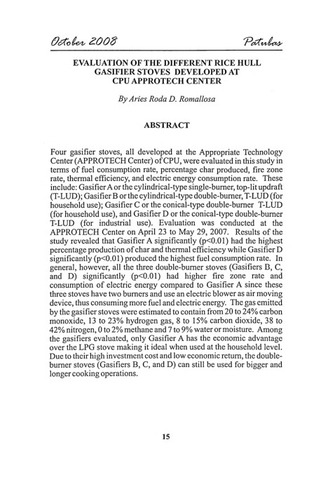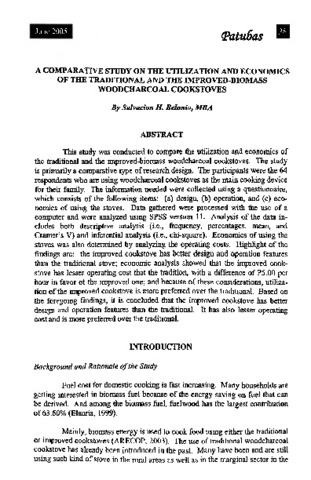Evaluation of the different rice hull gasifier stoves developed at CPU APPROTECH Center
| dc.contributor.author | Romallosa, Aries Roda D. | |
| dc.date.accessioned | 2021-04-07T05:38:33Z | |
| dc.date.available | 2021-04-07T05:38:33Z | |
| dc.date.issued | 2008-10 | |
| dc.identifier.citation | Romallosa, A. R. D. (2008). Evaluation of the different rice hull gasifier stoves developed at CPU Approtech Center. Patubas, 4(1), 15-31. | en_US |
| dc.identifier.issn | 1908-515X | |
| dc.identifier.uri | https://hdl.handle.net/20.500.12852/728 | |
| dc.description | Abstract only | en_US |
| dc.description.abstract | Four gasifier stoves, all developed at the Appropriate Technology Center (APPROTECH Center) of CPU, were evaluated in this study in terms of fuel consumption rate, percentage char produced, fire zone rate, thermal efficiency, and electric energy consumption rate. These include: Gasifier A or the cylindrical-type single-burner, top-lit updraft (T-LUD); Gasifier B or the cylindrical-type double-burner, T-LUD (for household use); Gasifier C or the conical-type double-burner T-LUD (for household use), and Gasifier D or the conical-type double-burner T-LUD (for industrial use). Evaluation was conducted at the APPROTECH Center on April 23 to May 29, 2007. Results of the study revealed that Gasifier A significantly (p<0.01) had the highest percentage production of char and thermal efficiency while Gasifier D significantly (p<0.01) produced the highest fuel consumption rate. In general, however, all the three double-burner stoves (Gasifiers B, C, and D) significantly (p<0.01) had higher fire zone rate and consumption of electric energy compared to Gasifier A since these three stoves have two burners and use an electric blower as air moving device, thus consuming more fuel and electric energy. The gas emitted by the gasifier stoves were estimated to contain from 20 to 24% carbon monoxide, 13 to 23% hydrogen gas, 8 to 15% carbon dioxide, 38 to 42% nitrogen, 0 to 2% methane and 7 to 9% water or moisture. Among the gasifiers evaluated, only Gasifier A has the economic advantage over the LPG stove making it ideal when used at the household level. Due to their high investment cost and low economic return, the double- burner stoves (Gasifiers B, C, and D) can still be used for bigger and longer cooking operations. | en_US |
| dc.language.iso | en | en_US |
| dc.publisher | Central Philippine University | en_US |
| dc.rights | Attribution-NonCommercial-NoDerivs 3.0 Philippines | * |
| dc.rights.uri | http://creativecommons.org/licenses/by-nc-nd/3.0/ph/ | * |
| dc.subject.lcsh | Rice hulls | en_US |
| dc.subject.lcsh | Rice hulls as fuel | en_US |
| dc.subject.lcsh | Stoves | en_US |
| dc.subject.lcsh | Stoves, Gas--Evaluation | en_US |
| dc.subject.lcsh | Stoves, Gas | en_US |
| dc.subject.lcsh | Stoves, Gas--Testing | en_US |
| dc.title | Evaluation of the different rice hull gasifier stoves developed at CPU APPROTECH Center | en_US |
| dc.title.alternative | Evaluation of the different rice hull gasifier stoves developed at Central Philippine University Appropriate Technology Center | en_US |
| dc.type | Article | en_US |
| dc.citation.firstpage | 15 | en_US |
| dc.citation.lastpage | 31 | en_US |
| dc.citation.journaltitle | Patubas | en_US |
| dc.citation.volume | 4 | en_US |
| dc.citation.issue | 1 | en_US |
| local.subject | Central Philippine University (CPU). Appropriate Technology Center (APPROTECH). | en_US |
이 항목의 파일
This item appears in the following Collection(s)
-
Journal articles [25]
-
Patubas [109]
Patubas is a refereed research journal of Central Philippine University.






